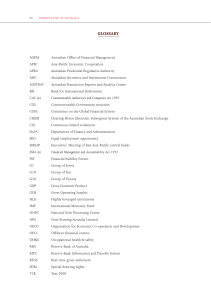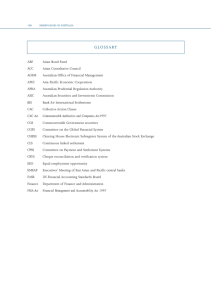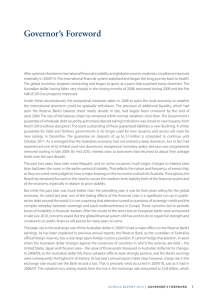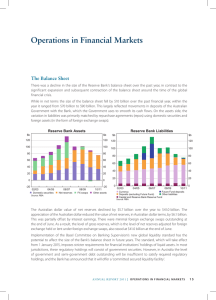Governor’s Foreword
advertisement
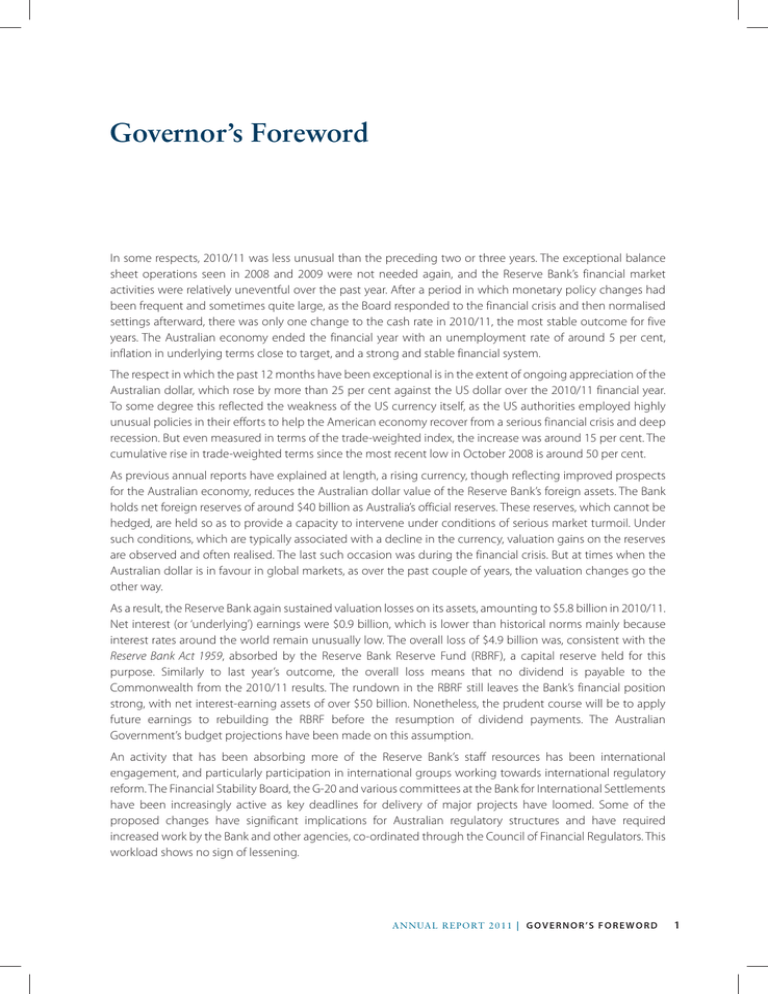
Governor’s Foreword In some respects, 2010/11 was less unusual than the preceding two or three years. The exceptional balance sheet operations seen in 2008 and 2009 were not needed again, and the Reserve Bank’s financial market activities were relatively uneventful over the past year. After a period in which monetary policy changes had been frequent and sometimes quite large, as the Board responded to the financial crisis and then normalised settings afterward, there was only one change to the cash rate in 2010/11, the most stable outcome for five years. The Australian economy ended the financial year with an unemployment rate of around 5 per cent, inflation in underlying terms close to target, and a strong and stable financial system. The respect in which the past 12 months have been exceptional is in the extent of ongoing appreciation of the Australian dollar, which rose by more than 25 per cent against the US dollar over the 2010/11 financial year. To some degree this reflected the weakness of the US currency itself, as the US authorities employed highly unusual policies in their efforts to help the American economy recover from a serious financial crisis and deep recession. But even measured in terms of the trade-weighted index, the increase was around 15 per cent. The cumulative rise in trade-weighted terms since the most recent low in October 2008 is around 50 per cent. As previous annual reports have explained at length, a rising currency, though reflecting improved prospects for the Australian economy, reduces the Australian dollar value of the Reserve Bank’s foreign assets. The Bank holds net foreign reserves of around $40 billion as Australia’s official reserves. These reserves, which cannot be hedged, are held so as to provide a capacity to intervene under conditions of serious market turmoil. Under such conditions, which are typically associated with a decline in the currency, valuation gains on the reserves are observed and often realised. The last such occasion was during the financial crisis. But at times when the Australian dollar is in favour in global markets, as over the past couple of years, the valuation changes go the other way. As a result, the Reserve Bank again sustained valuation losses on its assets, amounting to $5.8 billion in 2010/11. Net interest (or ‘underlying’) earnings were $0.9 billion, which is lower than historical norms mainly because interest rates around the world remain unusually low. The overall loss of $4.9 billion was, consistent with the Reserve Bank Act 1959, absorbed by the Reserve Bank Reserve Fund (RBRF), a capital reserve held for this purpose. Similarly to last year’s outcome, the overall loss means that no dividend is payable to the Commonwealth from the 2010/11 results. The rundown in the RBRF still leaves the Bank’s financial position strong, with net interest-earning assets of over $50 billion. Nonetheless, the prudent course will be to apply future earnings to rebuilding the RBRF before the resumption of dividend payments. The Australian Government’s budget projections have been made on this assumption. An activity that has been absorbing more of the Reserve Bank’s staff resources has been international engagement, and particularly participation in international groups working towards international regulatory reform. The Financial Stability Board, the G-20 and various committees at the Bank for International Settlements have been increasingly active as key deadlines for delivery of major projects have loomed. Some of the proposed changes have significant implications for Australian regulatory structures and have required increased work by the Bank and other agencies, co-ordinated through the Council of Financial Regulators. This workload shows no sign of lessening. AN N UAL R E P O RT 2 0 1 1 | G O v e r n o r ’s f o r e w o r d 1 The banking and payments group continued to upgrade key systems so as to provide greater efficiency and resilience. A notable activity was the use of the real-time payments system to make payments for the Australian Government to assist people affected by the Queensland floods in January. The Reserve Bank’s staff complement at the end of June 2011 was unchanged from a year earlier, although there were some changes in how those resources were allocated across the Bank. More resources were required for the Bank’s broader risk management activities, for the upgrading of IT systems in the banking and payments areas, and for analytical work on Asian economies, particularly China and India. Some reduction in resources was appropriate in the area of the Bank that operates the Government’s Guarantee Scheme for short-term funding and capital market instruments. There were also staffing reductions as a result of efficiency gains in some administrative support functions. Total operating costs increased by 4.1 per cent, the lowest rate of increase for seven years. The Reserve Bank Board farewelled three members over the past year: Ken Henry AC, Donald McGauchie AO and Warwick McKibbin. I want to thank all for their contribution to the Board’s deliberations and their support of the Bank more generally over the past decade. The Board welcomed the appointment of three new members – Catherine Tanna, Martin Parkinson PSM and John Edwards – each of whom brings extensive knowledge and experience to the deliberations of the Board. The Bank and the Board also marked the retirement of David Emanuel after 47 years of service, more than 20 years of which had been in the position of Secretary. Finally, I want to thank senior colleagues and the Reserve Bank staff once again for their professional and dedicated service in the interests of the Australian people. Glenn Stevens Chairman, Reserve Bank Board 25 August 2011 2 R es e rv e ba n k o f Aus tr a l i a
